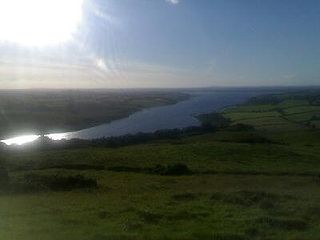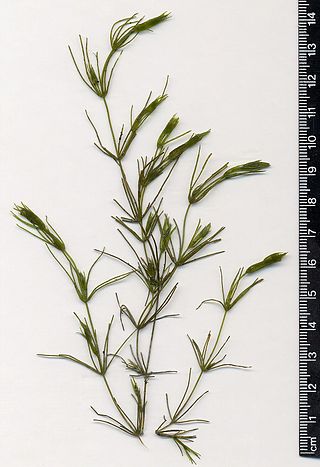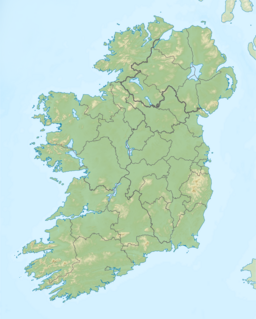
A turlough is a seasonal or periodic water body found mostly in limestone karst areas of Ireland, west of the River Shannon. The name comes from the Irish tur, meaning "dry", and loch, meaning "lake". The water bodies fill and empty with the changes in the level of the water table, usually being very low or empty during summer and autumn and full in the winter. As groundwater levels drop the water drains away underground through cracks in the karstic limestone.

Lough Derravaragh is a lake in County Westmeath, Ireland, north of Mullingar between Castlepollard, Crookedwood and Multyfarnham.

Lough Lene is a lake situated in north County Westmeath, Ireland, between the villages of Castlepollard, Collinstown and Fore.

Lough Oughter is a lake, or complex of lakes, in County Cavan covering more than 8,900 hectares. The complex of lakes lies on the River Erne, and forms the southern part of the Lough Erne complex. The lakes are bounded roughly by Belturbet in the north, Cavan town to the east, Crossdoney to the south and Killeshandra to the west.

Lough Bane is a lake on the border of County Meath and County Westmeath in Ireland. The county border runs east–west through the centre of the lake.

Chara is a genus of charophyte green algae in the family Characeae. They are multicellular and superficially resemble land plants because of stem-like and leaf-like structures. They are found in freshwater, particularly in limestone areas throughout the northern temperate zone, where they grow submerged, attached to the muddy bottom. They prefer less oxygenated and hard water and are not found in waters where mosquito larvae are present. They are covered with calcium carbonate (CaCO3) deposits and are commonly known as stoneworts. Cyanobacteria have been found growing as epiphytes on the surfaces of Chara, where they may be involved in fixing nitrogen, which is important to plant nutrition.

Lough Yganavan and Lough Nambrackdarrig are two lakes of ecological importance in County Kerry, Ireland. In 1988, Lough Nambrackdarrig and the southern half of Lough Yganavan were designated as National Nature Reserves. Since 1998, the lakes have been included in a Special Area of Conservation (SAC) of 271.6 hectares (3 km2), which protects land in private ownership and the two state-owned nature reserves. The habitats in the SAC include fixed dunes, a type of machair.
Kylecorragh Wood is an old oak woodland along the freshwater stretches of the River Nore in County Kilkenny, Ireland. Located 5 kilometres (3.1 mi) west of New Ross, it consists of 100 acres (400,000 m2). Kylecorragh Woods are of regional importance as an relatively undisturbed example of the original deciduous woodland which covered the river valley.

The Shannon Callows are areas of flat land along the shores of the River Shannon. These areas lie between Athlone in County Westmeath, where the river flows out of Lough Ree, and Portumna in County Galway, where it enters Lough Derg, in central Ireland. The shallow grade of the river here results in occasional flooding of the Callows.
Scohaboy Bog is a raised bog in County Tipperary in Ireland. It lies approximately 6 km northwest of Cloughjordan, County Tipperary, between the N52 and R490 roads.

Lough Arrow is a freshwater lake in the northwest of Ireland. This large, scenic lake covers an area of 12.47 square kilometres (4.8 sq mi) and lies mostly in County Sligo with a smaller part in County Roscommon. It is a popular trout fishing lake.

Lough Funshinagh is a lake and Special Area of Conservation in County Roscommon, Ireland, found to the west of Lough Ree. It has been called Ireland's amazing disappearing lake, due to the way it empties quickly - in as little as two days - and unpredictably, sometimes killing thousands of fish. Lough Funshinagh is one of a number of seasonal lakes, or turlough, found in the karst areas of Ireland, west of the River Shannon.
Annaghmore Lough is a freshwater lake in the west of Ireland. It is located in County Roscommon in the catchment of the upper River Shannon.

Ballynafagh Lake is a shallow alkaline lake, located approximately 2 km (1.2 mi) north-west of the village of Prosperous in County Kildare, Ireland. It is designated as a special area of conservation (SAC) and protected under European Union and Irish legislation. It is one of the European protected nature sites that comprise the Natura 2000 network. It is a short distance north of the Ballynafagh Bog.

The Rye Water Valley/Carton Special Area of Conservation or SAC is a Natura 2000 site based along the Rye Water / River Rye in north County Kildare, Ireland. It is protected as an SAC since November 2018 due to the presence of a rare hydrogeological habitat at a site close to the River Rye, and the presence of protected species.
The Mouds Bog Special Area of Conservation or SAC is a Natura 2000 site based close to the Hill of Allen and to Newbridge, County Kildare, Ireland. The qualifying interests by which it is protected as an SAC are the presence of three habitat types: the presence of active raised bogs, the presence of degraded raised bogs still capable of natural regeneration, and the presence of depressions on peat substrates of Rhynchosporion vegetation.
The Red Bog Special Area of Conservation or SAC is a Natura 2000 site in County Kildare, close to the town of Blessington in County Wicklow, Ireland. The qualifying interests by which it is protected as an SAC are the presence of a specific habitat type: transitional mires and quaking bogs.
The Carrigeenamronety Hill Special Area of Conservation or SAC is a Natura 2000 site in the Ballyhoura Mountains, Ireland. The qualifying interests for which it is protected as an SAC are the presence of the Killarney fern and the presence of a dry heath habitat.
The Ballynafagh Bog Special Area of Conservation or SAC is a Natura 2000 site in County Kildare, close to the town of Prosperous in County Kildare, Ireland. The three qualifying interests by which this site is protected as an SAC are the presence of active raised bog, of degraded raised bogs still capable of natural regeneration, and of depressions on peat substrates of the Rhynchosporion.
The Four Roads Turlough Special Area of Conservation is a Natura 2000 site based at the village of Four Roads, Ireland, close to Roscommon town, in County Roscommon, Ireland. The Four Roads Turlough is one of a number of seasonal lakes, or turloughs, found in the karst areas of Ireland, west of the River Shannon.














